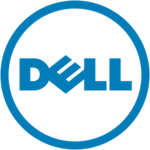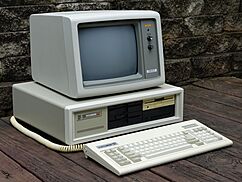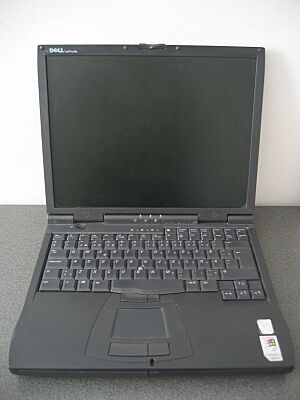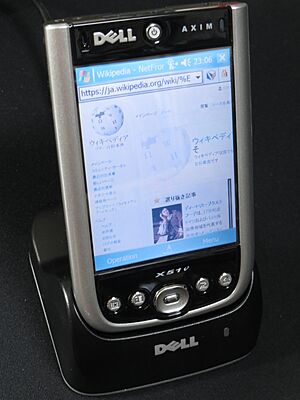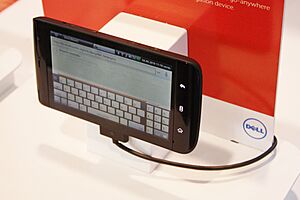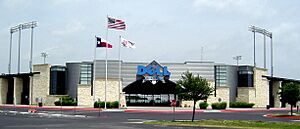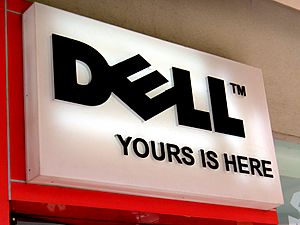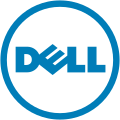Dell facts for kids
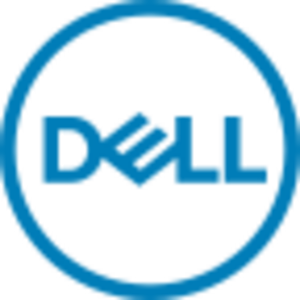
Logo since 2016
|
|
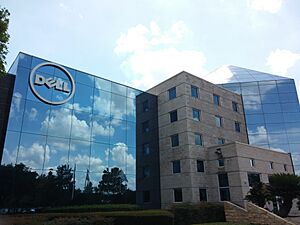
Headquarters in Round Rock, Texas
|
|
|
Formerly
|
|
|---|---|
| Subsidiary | |
| Traded as | NASDAQ: DELL
Nasdaq-100 component (until 2013) S&P 100 component (until 2013) S&P 500 component (until 2013) |
| Industry | |
| Founded | May 3, 1984 in Austin, Texas, U.S. |
| Founder | Michael Dell |
| Headquarters |
,
US
|
|
Area served
|
Worldwide |
|
Key people
|
|
| Products | |
| Revenue | |
|
Operating income
|
|
| Total assets | |
| Total equity | ▲ US$–2.3 billion (2024) |
|
Number of employees
|
c. 120,000 |
| Parent | Dell Technologies (2016–present) |
Dell Inc. is a big American technology company. It makes, sells, fixes, and helps with personal computers (PCs). Dell also works with servers, data storage devices, and software. You can find their main office in Round Rock, Texas.
Michael Dell started the company in 1984. Back then, Dell made computers similar to IBM PCs. They were special because they sold computers directly to customers at lower prices. This helped Dell grow very fast in the 1990s. By 2001, Dell became the biggest PC seller in the world.
At first, Dell only sold computer parts. But in 2009, they bought a company called Perot Systems. This allowed Dell to start offering IT services too. Dell kept growing its storage and networking systems. By the late 2000s, they offered a wide range of technology for businesses.
Dell is now part of Dell Technologies. It is one of the largest companies in Texas by how much money it makes. As of 2024, Dell is the third-largest personal computer seller worldwide. Only Lenovo and HP sell more. In 2015, Dell bought EMC Corporation. This made Dell Technologies even bigger. Dell EMC now sells data storage, security, and cloud computing services.
Contents
- Dell's Journey: A History of Innovation
- How Dell Works: Business and Operations
- Dell Products: What They Make
- Keeping Things Safe: Security at Dell
- Selling Dell Products: Marketing and Stores
- Dell and the Environment
- Images for kids
- See also
Dell's Journey: A History of Innovation
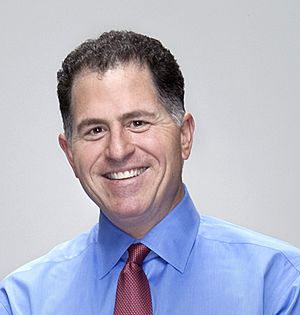
How Dell Started: From Dorm Room to Big Business
Michael Dell started Dell Computer Corporation in 1984. He was a student at the University of Texas at Austin. He worked from his dorm room, calling his company PC's Limited. His idea was to sell computers built from parts directly to customers. Michael believed this would help him understand what customers needed.
He left college after his first year to work on his business full-time. He got about $1,000 from his family to help his company grow. By April 2021, Michael Dell's wealth was estimated to be over $50 billion.
In 1985, PC's Limited launched its first computer, the "Turbo PC." It cost US$795. This computer had an Intel 8088-compatible processor that could run at 8 MHz. PC's Limited advertised these computers in national magazines. They built each computer to order based on what the customer wanted. This way, they could offer lower prices than stores. The company made over $73 million in its first year.
In 1987, the company changed its name to Dell Computer Corporation. This new name showed that they were growing into a bigger business. They started expanding around the world, first in Britain. By June 1988, Dell Computer was worth $80 million. In 1989, Dell started offering on-site service to customers. They also launched their first laptop, the Dell 316LT.
Growing Big: Dell in the 1990s and Early 2000s
In 1990, Dell tried selling computers in big stores, but it didn't work well. So, they went back to selling directly to customers. In 1992, Fortune magazine listed Dell Computer Corporation as one of the world's 500 largest companies. Michael Dell was the youngest CEO on that list.
Dell realized that selling laptops was more profitable. After some changes, they launched the Dell Latitude laptop line in 1994. These laptops became very popular.
Dell didn't focus much on individual customers at first. But this changed when their website became popular in 1996 and 1997. People who already knew a lot about computers liked buying directly from Dell. They could customize their PC and get it delivered quickly. In 1997, Dell created a team just for selling to homes.
| Year | Revenue
(mill. US$) |
No. of
employees |
|---|---|---|
| 1990 | 546 | 2,050 |
| 1991 | 889 | 2,970 |
| 1992 | 2,013 | 4,650 |
| 1993 | 2,873 | 5,980 |
| 1994 | 3,475 | 6,400 |
| 1995 | 5,296 | 8,400 |
| 1996 | 7,759 | 10,350 |
| 1997 | 12,327 | 16,000 |
| 1998 | 18,243 | 24,400 |
| 1999 | 25,256 | 36,500 |
From 1997 to 2004, Dell kept growing and took market share from other companies. Many rival PC makers struggled or were bought out. Dell became the largest PC maker in 1999. In 2002, Dell expanded its products to include TVs, handheld devices, and printers.
In 2003, the company officially changed its name to "Dell Inc." This showed that they were selling more than just computers. In 2004, Michael Dell stepped down as CEO but remained chairman. Kevin Rollins became the new CEO. Under Rollins, Dell bought the gaming computer maker Alienware in 2006.
Important Changes and Challenges
In 2005, Dell's sales growth slowed down. The company's stock value dropped. This was partly because the PC market was becoming more mature. Dell's main advantage was making desktop PCs very cheaply. But other companies like Hewlett-Packard and Acer became more efficient too. This made Dell's price advantage less special.
Laptops became the fastest-growing part of the PC market. However, Dell made low-cost notebooks in China, just like other companies. This meant Dell didn't have a special cost advantage anymore. Also, Dell mainly sold online, missing out on growing laptop sales in big stores.
Dell was known for selling existing technologies at low prices. They didn't spend as much on research and development (R&D) as companies like IBM or Apple Inc.. This helped them keep prices low for PCs, but it made it harder to create new, exciting products like MP3 players or mobile devices.
Dell also faced criticism for its customer service. As the company grew, its technical support struggled to keep up. Dell worked hard to improve this, spending $100 million to make things better. They launched a blog called Direct2Dell and a website called IdeaStorm.com to get ideas from customers.
In 2006, Dell's growth was slower than the rest of the PC industry. By the end of 2006, Hewlett-Packard took over as the largest PC manufacturer.
Michael Dell Returns as CEO
After several quarters of lower-than-expected earnings, Kevin Rollins resigned as CEO in January 2007. Founder Michael Dell returned as CEO. He announced a plan called "Dell 2.0" to improve the company. This included reducing the number of employees and offering more diverse products.
Dell closed some of its call centers in Canada in 2008 to cut costs. They also closed plants that made desktop computers in the US. Much of this work moved to factories in Asia and Mexico. In 2009, Dell closed its manufacturing plant in Ireland, moving production to Poland.
Trying New Things: Diversification Efforts
When Apple's iPad came out, it affected Dell and other PC makers. Many people started buying tablets instead of laptops. Dell tried to make its own smartphones and tablets, but they didn't do very well. For example, the Dell Streak tablet was not successful.
Dell started focusing on higher-end PCs, like the XPS line of notebooks. These computers didn't compete directly with tablets like the iPad. But the growing popularity of smartphones and tablets still hurt Dell's consumer business. Dell continued to lose market share in the shrinking PC industry. By 2011, they were number three in the world, behind Lenovo.
To make up for the declining PC business, Dell tried to expand into other areas. They focused on servers, networking, software, and services for businesses. They spent $13 billion on buying other companies to offer more than just hardware. However, the market still wasn't sure if Dell could succeed in a "post-PC" world.
Becoming a Private Company (2013)
In February 2013, Dell announced a huge deal to become a private company. This meant its shares would no longer be traded on stock exchanges like NASDAQ. Michael Dell and a company called Silver Lake Partners bought all the public shares for $24.4 billion. This was the largest technology buyout ever at the time.
Michael Dell said this deal would start an "exciting new chapter" for the company. Other companies like Blackstone Group and Carl Icahn also showed interest in buying Dell. But in the end, Michael Dell's offer was accepted. On October 30, 2013, Dell stopped being a publicly traded company after 25 years.
After going private, Dell offered a program for employees to leave voluntarily. So many people took this offer that Dell had to hire new staff to fill the gaps.
Recent Developments: Big Acquisitions
On October 12, 2015, Dell announced its plan to buy EMC Corporation. This was a massive deal, worth $67 billion, making it the largest acquisition in the technology world. As part of this deal, Dell also took over EMC's large share in VMware, a company that specializes in virtualization and cloud computing.
This merger brought together Dell's computers and servers with EMC's data storage business. It was a big step for Dell to offer a complete range of IT products and services. After the acquisition, Dell started publishing its financial results again.
On September 7, 2016, the merger with EMC was completed. The combined company became Dell Technologies. It was organized into three main parts: Client Solutions Group (for PCs), Infrastructure Solutions Group (for servers and storage), and VMware.
In July 2018, Dell announced it wanted to become a public company again. They planned to buy back shares from their stake in VMware. After some discussions, Dell became a public company once more. The original Dell computer business and Dell EMC now operate under the parent company, Dell Technologies.
In January 2021, Dell reported $94 billion in sales for 2020. In March 2024, Dell's stock reached an all-time high. This was because of strong performance from its artificial intelligence (AI) unit. In August 2024, the company announced it would reduce its workforce by 10% to invest more in AI.
Dell and AMD Processors
For a long time, Dell mainly used Intel processors in its computers. But in 2006, when Dell bought Alienware, some Alienware systems already had AMD chips. On August 17, 2006, Dell announced that some of its desktop computers would start using AMD processors. Later that year, they also released servers with AMD chips.
Dell's CEO, Kevin Rollins, said this change was due to lower costs and AMD's technology. By November 2006, Dell's website started offering laptops with AMD processors too.
Dell and Linux Operating System
In 1998, a consumer advocate asked Dell to offer other operating systems besides Microsoft Windows, like Linux. By 2000, Dell started offering Linux on some of its laptops. They became the first major manufacturer to offer Linux across their full product line. However, by early 2001, Dell stopped this Linux business unit.
On February 26, 2007, Dell announced they would start selling computers with Linux pre-installed. They first mentioned Novell's SUSE Linux. The next day, they clarified that they were certifying hardware for SUSE Linux, but not yet selling systems with it pre-installed. However, on March 28, 2007, Dell confirmed they would ship some desktops and laptops with Linux.
On May 1, 2007, Dell announced they would ship the Ubuntu Linux distribution. By May 24, 2007, Dell began selling models with Ubuntu Linux 7.04 already installed. These included a laptop, a budget computer, and a high-end PC. Dell continued to expand its Linux offerings to other countries. As of 2021, Dell still offers select laptops and workstations with Ubuntu Linux pre-installed, called "Developer Edition" models.
How Dell Works: Business and Operations
Business Performance Over Time
Here's a look at Dell's business trends over the years (ending late January/early February):
| Revenue (US$ bn) | Net profit (US$ bn) | Employees (k) | |
|---|---|---|---|
| 2016 | 50.5 | −1.1 | 101 |
| 2017 | 61.5 | −3.6 | 138 |
| 2018 | 79.1 | −2.8 | 145 |
| 2019 | 90.3 | −2.3 | 157 |
| 2020 | 91.9 | 4.6 | 165 |
| 2021 | 86.7 | 2.2 | 158 |
| 2022 | 101 | 4.9 | 133 |
| 2023 | 101 | 2.4 | 133 |
| 2024 | 88.4 | 3.2 | 120 |
Who Leads Dell?
The company is guided by a board of nine directors. Michael Dell, the founder, is the chairman and CEO. The board makes big decisions for the company. Day-to-day operations are managed by the Global Executive Management Committee.
Leaders of Dell
- Chairmen:
* Michael Dell (1984–present)
- Chief Executives:
* Michael Dell (1984–2004) * Kevin Rollins (2004–2007) * Michael Dell (2007–present); second time as CEO
Dell's Catchy Slogans
Dell has used many slogans over the years to advertise its products:
- Be direct (1998–2001)
- Easy as Dell (2001–2004)
- Get more out of now (2004–2005)
- It's a Dell (2005–2006)
- Dell. Purely You (2006–2007)
- Yours is Here (2007–2011)
- The power to do more (2011–present)
Companies Dell Has Acquired
Dell has bought many companies to grow its business and offer more products and services.
| Company acquired | Date of acquisition | What the company did | References |
|---|---|---|---|
| Alienware | 2006 | Makes high-end PCs for gamers | |
| EqualLogic | January 28, 2008 | Helped Dell get into the storage market. | |
| Perot Systems | 2009 | A company that offered technology services and outsourcing. | |
| KACE Networks | February 10, 2010 | A leader in systems management tools. | |
| Boomi | November 2, 2010 | A leader in cloud integration. | |
| Compellent Technologies | February 2011 | Expanded Dell's storage products. | |
| Force10 networks | August 2011 | Gave Dell full ownership of its networking technology. | |
| AppAssure Software | February 24, 2012 | Provided backup and disaster recovery software. | |
| SonicWall | May 9, 2012 | Developed security products for networks and data. | |
| Wyse | April 2, 2012 | A top company for thin client systems. | |
| Clerity Solutions | April 3, 2012 | Offered services for moving and updating applications. | |
| Quest Software | September 28, 2012 | ||
| Gale Technologies | November 16, 2012 | Provided tools for automating computer infrastructure. | |
| Credant Technologies | December 18, 2012 | Offered services for protecting stored data. | |
| StatSoft | March 24, 2014 | A global provider of analytics software. | |
| EMC² | October 12, 2015 | Focused on storage, virtualization, cloud, and security. |
Where Dell Works: Facilities Around the World
Dell's main office is in Round Rock, Texas. As of 2013, about 14,000 people worked for Dell in central Texas. This made Dell the biggest private employer in the area. The Round Rock headquarters has over 2 million square feet of space.
Dell used to have its headquarters in Austin, Texas. But in the mid-1990s, they started moving most of their employees to Round Rock. By 1996, Dell was officially moving its headquarters there.
In 2008, Dell changed its Round Rock headquarters to use more environmentally friendly power sources. 60% of the power came from wind farms. The other 40% came from a plant that uses gas from a landfill.
Dell has facilities in many places around the world. In the United States, they have offices in Texas, New Hampshire, Tennessee, and other states. Outside the US, Dell has facilities in Malaysia, China, the UK, the Philippines, India, Brazil, Slovakia, Poland, Panama, Ireland, Morocco, and France.
The US and India are the only countries where Dell has all its business functions. This includes research, manufacturing, finance, and customer care.
How Dell Makes Products: Manufacturing
From the beginning, Dell was special because it built computers to order. This means customers could choose exactly what they wanted. Most other computer makers at the time made large batches of computers and sold them to stores.
Dell tries to make its products close to its customers. This helps them deliver products quickly. It also allows them to use a "just-in-time" approach. This means they keep very little inventory, which saves money. This is important because computer parts can lose value very fast.
Dell's manufacturing process includes putting parts together, installing software, and testing everything. For most of its history, Dell made desktop computers themselves. They would then customize notebooks that were made by other companies.
However, Dell's approach has changed over time. By the late 2000s, making individual PCs in the US was not as efficient. Many Asian manufacturers could make computers cheaper. Dell closed some of its desktop computer plants in the US. Much of this work moved to manufacturers in Asia and Mexico. Dell still makes its profitable servers in Austin, Texas.
Dell also used to assemble computers for Europe, the Middle East, and Africa in Ireland. But in 2009, they moved this production to a new plant in Poland.
Dell Products: What They Make
Different Brands for Different Needs
Dell sells different brands of products for different types of customers.
For businesses and offices, they have:
- OptiPlex (office desktop computers)
- Vostro (desktops and laptops for small businesses)
- Latitude (laptops for businesses)
- Precision (powerful computers for demanding tasks)
- PowerEdge (servers for businesses)
- PowerVault (storage devices)
- Force10 and PowerConnect (network switches)
- Dell Compellent and EqualLogic (storage systems)
For home users and consumers, Dell offers:
- Inspiron (everyday desktop and laptop computers)
- XPS (high-end desktop and laptop computers)
- G Series (gaming laptops)
- Alienware (very powerful gaming systems)
- Venue (Tablets with Android or Windows)
Dell also makes other computer parts like USB drives, LCD televisions, and printers. Their Dell UltraSharp monitors are known for high quality.
Dell's support services include Dell Solution Station and Dell Business Support.
Some products and brands that Dell no longer makes include:
- Axim (PDAs, stopped in 2007)
- Dimension (home desktop computers, stopped in 2007)
- Dell Digital Jukebox (MP3 player, stopped in 2006)
- Dell Unix (an operating system, stopped in 1993)
Keeping Things Safe: Security at Dell
eDellRoot Certificate Issue
In November 2015, it was found that some Dell computers came with a special pre-installed certificate called "eDellRoot." This caused security risks because it could allow attackers to pretend to be secure websites. Dell apologized and offered a tool to remove it.
Dell Foundation Services Tracking
Also in November 2015, a problem was found with Dell's diagnostic program, Dell Foundation Services. This program could track customers using a unique service tag number. This was possible even if customers tried to browse privately. It was recommended that Dell customers uninstall the program until the issue was fixed.
Selling Dell Products: Marketing and Stores
How Dell Advertises
Dell advertises in many ways, including on TV, the Internet, and in magazines. They often lower prices, offer free bonus products, or provide free shipping to attract customers. In 2006, Dell cut its prices to keep its market share. This also meant they made less profit on each sale. To keep prices low, Dell mostly sells online or by phone. They also moved some customer service to other countries to save money.
In the early 2000s, Dell had a famous TV ad campaign with an actor playing "Steven." He would help people with computer problems and end with the line: "Dude, you're gettin' a Dell!"
In 2007, Dell started using the slogan "Yours is Here." This slogan highlighted that they customize computers to fit what customers need.
Dell also hosts a conference called "Dell World" in Austin, Texas. This event shows off new technology and services from Dell and its partners.
Dell in Stores: Retail Sales
In the early 1990s, Dell sold products in stores like Best Buy and Costco. But they stopped this in 1994 to focus only on direct sales. In 2007, Dell started selling its products in major US stores again, like Sam's Club and Wal-Mart. Later, Staples and Best Buy also became Dell retail partners.
Kiosks and Retail Stores
Starting in 2002, Dell opened small kiosks in the US. These allowed customers to see products before buying them directly. By 2005, Dell expanded these kiosks to Australia, Canada, Singapore, and Hong Kong. However, in 2008, Dell closed all 140 kiosks in the US because they were expanding into bigger retail stores.
In Canada, Dell products started shipping to Staples Business Depot in 2008. In April 2008, Future Shop and Best Buy also began selling some Dell products.
Dell also opened retail stores in some countries in Central Europe and Russia. In April 2007, a Dell store opened in Budapest, and in October, one opened in Moscow. In the UK, stores like HMV, Currys, PC World, and Tesco started selling Dell products.
In Australia, Dell partnered with Officeworks in 2008. They also expanded to other retailers like Harris Technology and The Good Guys. By 2009, Dell products were available in Dick Smith Electronics stores across Australia and New Zealand. However, Dell closed its Australian/New Zealand kiosk program in March 2010.
In Germany, Dell sells some smartphones and notebooks in stores like Media Markt and Saturn.
Who Dell Competes With
Dell has many competitors in the technology market. These include Lenovo, Hewlett-Packard (HP), Acer, Fujitsu, Sony, Asus, Samsung, and Apple. Dell and its Alienware brand also compete with other companies that make high-performance gaming computers.
In late 2006, Dell lost its spot as the top PC seller to Hewlett-Packard. HP's growth was much faster than Dell's at that time. By the end of 2006, Dell's share of the PC market was 13.9%, while HP's was 17.4%. As of 2021, Dell is the third-largest PC manufacturer, after Lenovo and HP.
Working with EMC
In 2001, Dell and EMC started working together. They designed products jointly, and Dell supported some EMC storage systems. This partnership helped both companies sell more. In 2008, they extended their partnership until 2013. Dell also added EMC storage systems to its product line.
However, in October 2011, Dell stopped reselling EMC storage products, ending the partnership early. Later, as mentioned before, Dell would go on to acquire and merge with EMC in a huge tech deal.
Dell and the Environment
Dell is committed to being an environmentally friendly company. They aimed to reduce greenhouse gas emissions from their global activities by 40% by 2015. Dell is also listed in Greenpeace's Guide to Greener Electronics, which scores electronics makers on their environmental policies. In November 2011, Dell ranked 2nd out of 15 companies on this list.
Dell was the first company to announce a plan to remove toxic chemicals like polyvinyl chloride (PVC) and brominated flame retardants (BFRs) from its products. They planned to do this by the end of 2009, but later changed the goal to the end of 2011 for computing products. In March 2010, Greenpeace protested at Dell offices, asking them to remove these chemicals faster. Dell launched its first products completely free of PVC and BFRs with its G-Series monitors in 2009.
In a 2012 report on conflict minerals, Dell was ranked among the top companies for its efforts.
Green Initiatives at Dell
Dell was the first company in the information technology industry to set a goal for recycling products in 2004. By 2006, they had a global recycling program for consumers. In 2007, Dell received an award for its efforts to promote producer responsibility in recycling.
On July 19, 2007, Dell announced that it had collected 78 million pounds of IT equipment from customers in 2006. This was a 93% increase from 2005.
On June 5, 2007, Dell set a long-term goal to become the greenest technology company on Earth. Their "zero-carbon" plan includes:
- Reducing Dell's carbon footprint by 15% by 2012.
- Asking their main suppliers to report carbon emissions.
- Working with customers to build the "greenest PC on the planet."
- Expanding their "Plant a Tree for Me" program, which helps offset carbon emissions.
Dell shares its environmental performance in an annual report called the Corporate Social Responsibility (CSR) Report. This report shows how Dell is working to reduce its impact on the environment through energy-efficient products and programs.
Images for kids
See also
 In Spanish: Dell para niños
In Spanish: Dell para niños


